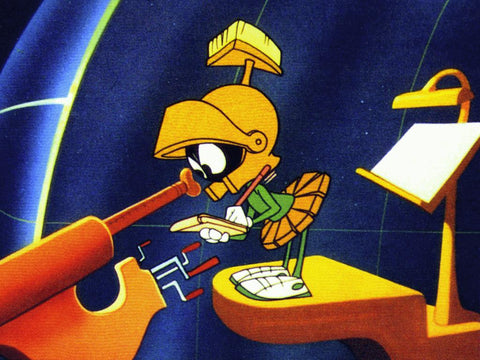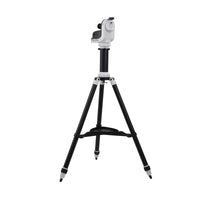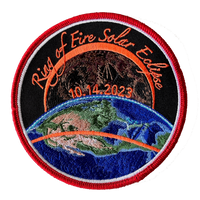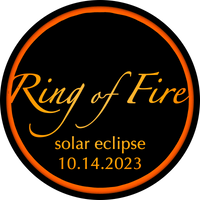
How To Choose A Telescope for Kids
I see too many very well intending parents buy the toy store telescope (often with an included microscope), only to find the whole experience of trying to setup and use their child's new prize to be a frustrating, rather than amazing, experience for them and their child.
A Little Story about a Too-little Telescope
 A few weeks ago at an astronomical club open house, some kids and their dad brought in a little telescope he'd gotten them. This was one of those $20 toy store items. It had a shaky little tripod that you would sit on a table (the legs didn't extend), a very small aperture lens (about 30mm) and a couple of very cheap plastic eyepieces. The family was frustrated because they weren't able to see anything through this little telescope, and even had trouble getting it pointed at the Moon. One of the other club members very patiently helped the kids out with their little scope, explaining the parts of it, how everything worked, and how to point it at the Moon. He also explained the limits of this little toy, and that the Moon was really about all they would be able to use it to really see.
A few weeks ago at an astronomical club open house, some kids and their dad brought in a little telescope he'd gotten them. This was one of those $20 toy store items. It had a shaky little tripod that you would sit on a table (the legs didn't extend), a very small aperture lens (about 30mm) and a couple of very cheap plastic eyepieces. The family was frustrated because they weren't able to see anything through this little telescope, and even had trouble getting it pointed at the Moon. One of the other club members very patiently helped the kids out with their little scope, explaining the parts of it, how everything worked, and how to point it at the Moon. He also explained the limits of this little toy, and that the Moon was really about all they would be able to use it to really see.
While very well intended, this little toy telescope was a disappointment for everyone involved.
Buy a Tool, Not a Toy
Just about any telescope sold for under $100 will be no good as a telescope (there are a few - very few - exceptions we will get to in a moment). Most likely, any cheap big box or toy store telescope will quickly make its way to a dusty corner of the garage. What's the solution? Don't think of a telescope as a toy, but as a tool of discovery! Only in your imagination would you try climb a mountain with a plastic pick axe from a junior explorer's kit. If you want to climb a real mountain, you need real tools. In the same way, you can't expect to really see the stars with a toy telescope. When you look at a telescope as a tool instead of a toy, you are purchasing a real key to the cosmos.
Does that mean telescopes aren't for kids? Telescopes absolutely are for kids! It's just the difference between a toy and a tool. Kids can go crazy with their toys, but need a little help and guidance using the real tools. A telescope is something that can help teach kids respect for their things, because the rewards are the Moon and the Stars!
How do you tell the Tools from the Toys?
Price and Magnification! If the box advertises really high magnification (200x, 400x, etc) then you are looking at a toy. Magnification is the gimmick used to sell many cheap telescopes. Most experienced astronomers know the important thing isn't magnification, it's aperture.
A little about magnification: A simple rule of thumb is the maximum useful magnification of a telescope is going to be the aperture in millimeters multiplied by 2. (If the aperture is listed in inches, multiply the aperture by 50). There is, however, an upper limit of about 300x for even very large aperture telescopes. Even if you have a 12" aperture telescope, due to atmospheric conditions, the maximum useful magnification is about 300x, and that's on a good night with little air turbulence (no twinkle in the stars). Most amateur astronomers spend the majority of their observing time using their telescopes at less than 60x magnifying power.

Why is Aperture important?
Aperture is the diameter of the lens or mirror of the telescope, which determines how much light the telescope can gather. Astronomy isn't about how much we can magnify something, but about how much light we can collect from it. Think of it this way: the pupil in your eye, when fully dilated, is about 7mm in diameter. You want to look at an object in the night sky, say the Orion Nebula, that is shining light from thousands of lightyears away. That 7mm pupil means your eye, when you look up towards Orion, is only picking up a few photons of light from those distant stars at any moment. You don't need magnification to see - you need a bigger pupil! That's what a telescope really is, a bigger eye. Or rather, a lens that acts to focus more of those precious photons of light into your eye.
Let's play with a little math
How much light does a telescope gather? Lets say we have a telescope with a 100mm aperture lens. Lenses or mirrors in telescopes, just like the pupil in our eyes, are round, which means we get to play with that most delicious number, Pi!
What we want to know is how much area that lens covers compared to our pupil. So, our old friend Pi comes in to help. We know the area of a circle is Pi x the radius squared. So, 3.14 x 50^2 = 7853 square mm.
Our pupil has an area of just 38 square millimeters (3.14 x 3.5^2), so that telescope with the 100mm aperture will gather 206 times more light than our eyeball alone - that's serious light gathering!
Avoid Equatorial Mounts
 Equatorial mounts are designed to have one axis of rotation parallel with the rotation of the Earth. This is accomplished by setting the EQ mount altitude adjustment to match the latitude of your location (for Denver, CO, this is 39.7° North). This is different compared to a simple alt-az mount, where the axis of motion are simply up-down and left-right.
Equatorial mounts are designed to have one axis of rotation parallel with the rotation of the Earth. This is accomplished by setting the EQ mount altitude adjustment to match the latitude of your location (for Denver, CO, this is 39.7° North). This is different compared to a simple alt-az mount, where the axis of motion are simply up-down and left-right.
Equatorial mounts are more complex to setup and use compared to alt-az mounts, but you will see a lot of inexpensive telescopes on manual EQ mounts. Part of the reason for this is these mounts are cheap, and manufacturers can put a big bulky and impressive looking telescope on a small EQ mount. The problem with this is these telescopes are unstable on their little mounts, and this quickly leads to frustration. Our advice is just avoid the EQ mounts when looking for a telescope for the kids.
How much do I have to spend?
 We've established that the toy store telescopes are out, so what does a real telescope cost? As mentioned above, you can find a decent starter telescope for about $100. In fact, there are several good options in the $100-$250 range. If you expect this to be a long term hobby for you and your child, you might consider larger aperture telescopes, like a 6" or 8" Dobsonian, which will be about $300-$400. An 8" Dobsonian is fairly large, best suited to kids 10 and up, and not something they could easily setup on their own. It is however a lifetime instrument for many amateur astronomers, providing a good balance of aperture (light gathering), size, portability (for an adult), and price.
We've established that the toy store telescopes are out, so what does a real telescope cost? As mentioned above, you can find a decent starter telescope for about $100. In fact, there are several good options in the $100-$250 range. If you expect this to be a long term hobby for you and your child, you might consider larger aperture telescopes, like a 6" or 8" Dobsonian, which will be about $300-$400. An 8" Dobsonian is fairly large, best suited to kids 10 and up, and not something they could easily setup on their own. It is however a lifetime instrument for many amateur astronomers, providing a good balance of aperture (light gathering), size, portability (for an adult), and price.
 A refracting telescope with a 70mm aperture lens is a nice portable telescope that won't break the bank, but will put you and your child on the path of enjoying the stars. The Celestron Travel Scope 70 even comes with its own backpack for just under $100, and will still deliver 100x more light than your eye alone. The tripod is a bit small and a little shaky, but this is still a great starter telescope for the price.
A refracting telescope with a 70mm aperture lens is a nice portable telescope that won't break the bank, but will put you and your child on the path of enjoying the stars. The Celestron Travel Scope 70 even comes with its own backpack for just under $100, and will still deliver 100x more light than your eye alone. The tripod is a bit small and a little shaky, but this is still a great starter telescope for the price.
To Compute or not
So far, we've talked about manual telescopes, but once you get past the toy store offerings, you'll probably be confronted with another choice: A computerized telescope.
 Computerized telescopes can be fantastic tools, if you and your child are willing to take the time to learn to use them! Respectable computerized telescopes with a GoTo capability can be found starting at under $500. A GoTo telescope, after a setup routine, will allow you to select an object by name using a hand control, and the telescope will point to it. This makes it easier to find some of those faint fuzzy galaxies and nebula, but at a price: you have to read the manual!
Computerized telescopes can be fantastic tools, if you and your child are willing to take the time to learn to use them! Respectable computerized telescopes with a GoTo capability can be found starting at under $500. A GoTo telescope, after a setup routine, will allow you to select an object by name using a hand control, and the telescope will point to it. This makes it easier to find some of those faint fuzzy galaxies and nebula, but at a price: you have to read the manual!
 If you love technology, some of the latest telescopes, the Celestron Evolution series, even offer built-in wifi to work with planetarium apps on your phone to let you control your telescope! These are of course a bigger investment - expect to spend $1300 and up, but you will get a fantastic instrument with exceptional optics for many hours of stargazing. These scopes are good even for younger kids, with adult help.
If you love technology, some of the latest telescopes, the Celestron Evolution series, even offer built-in wifi to work with planetarium apps on your phone to let you control your telescope! These are of course a bigger investment - expect to spend $1300 and up, but you will get a fantastic instrument with exceptional optics for many hours of stargazing. These scopes are good even for younger kids, with adult help.
Final Thoughts
- Find a local astronomy club for some first-hand eyes-on experience with some different telescopes.
- Buy from a telescope retailer that can provide knowledgable guidance and support.
- Get involved with your kids learning how to setup the telescope and discover the night sky.
- Read more about how to choose a telescope.
- See our list of the best telescopes for kids and families.




